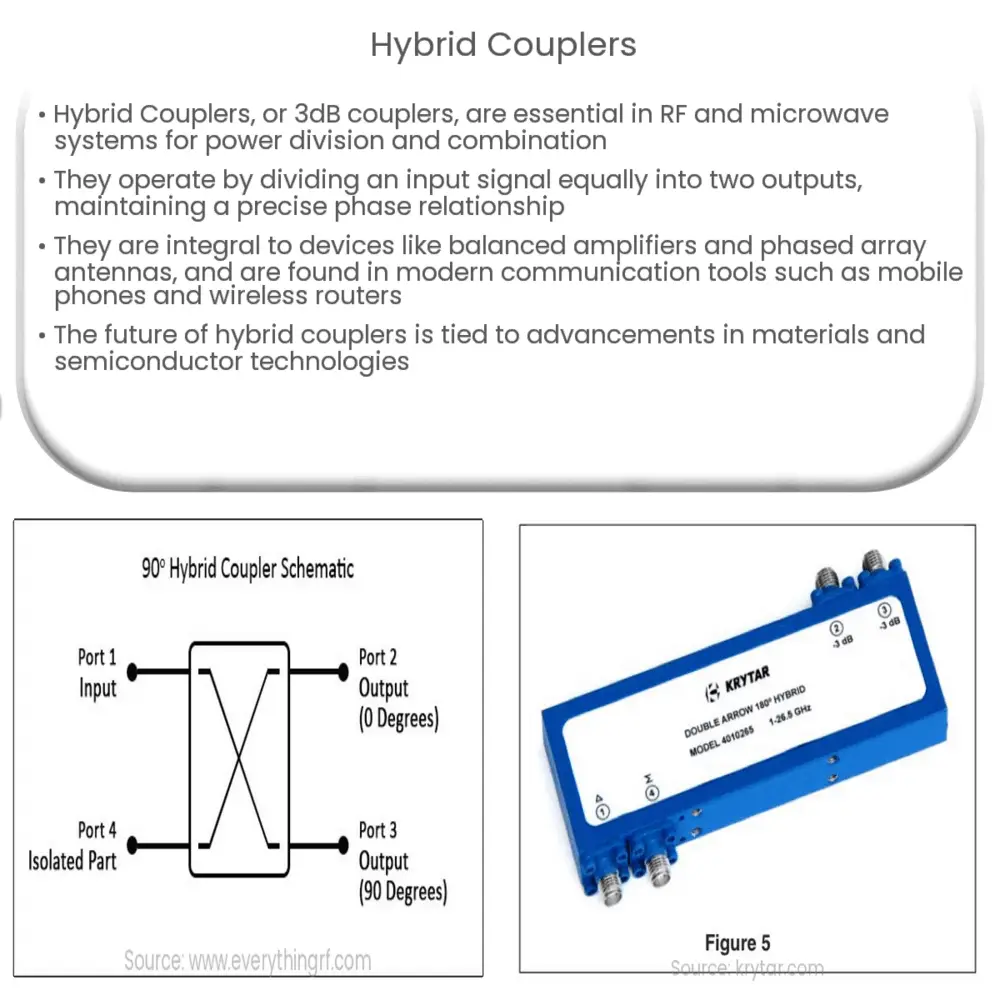Explore the world of Hybrid Couplers, their design, operation, and applications in RF and microwave systems in this comprehensive guide.

Introduction to Hybrid Couplers
Hybrid Couplers, sometimes referred to as 3dB couplers, are fundamental components of RF and microwave systems. These passive devices are crucial for power division and combination purposes, performing important roles in balanced amplifiers, antenna beamforming networks, and signal distribution systems.
Principle of Operation
The basic operational principle of a hybrid coupler is quite simple: it takes an input signal and divides it into two output signals. In an ideal hybrid coupler, the division is equal—half of the input power goes to each output, hence the alternative name “3dB coupler,” as 3dB represents a halving of power. These signals, furthermore, maintain a precise phase relationship, typically either 0° or 90°, depending on the specific design of the coupler.
- Quadrature Hybrid Coupler: This is a four-port device where the output signals have a 90° phase difference. These are commonly used in balanced amplifier designs and monopulse comparator networks.
- Rat-Race Coupler: This is another type of four-port device, which provides equal power split but with a 180° phase difference. Its unique circular design gives it the name “rat-race.
Design and Construction
Hybrid couplers can be built using various technologies, such as stripline, microstrip, and waveguide, depending on the frequency and power requirements. The design process typically requires careful consideration of factors like impedance, isolation, insertion loss, and VSWR (Voltage Standing Wave Ratio). In addition, materials with specific dielectric properties are selected to optimize performance.
Applications of Hybrid Couplers
Hybrid couplers find application in numerous RF and microwave systems. They are critical in the construction of balanced amplifiers, where they ensure the proper power division and phase relationship between the amplifier stages. In phased array antennas, they are used in the beamforming network to provide precise control over the antenna radiation pattern.
In addition, hybrid couplers are used in test and measurement setups for splitting and combining signals. In signal distribution systems, they are used to divide a high-power input signal into multiple lower-power signals, ensuring that the signals are evenly distributed throughout the system.
Significance in Modern Communication Systems
Modern communication systems extensively utilize hybrid couplers for their inherent benefits. In optical communication systems, hybrid couplers made from waveguides are crucial for their ability to combine or split optical signals effectively. These couplers are also found in digital communication devices such as mobile phones, wireless routers, and GPS devices, where they contribute to effective signal processing.
Challenges and Future Trends
As communication systems continue to evolve, hybrid couplers face several challenges. For instance, the need for more compact, cost-effective designs that can handle higher frequencies and power levels, is becoming increasingly important. Additionally, there’s a growing demand for hybrid couplers that can operate efficiently over a broader bandwidth.
The advancement in semiconductor and materials technology is likely to influence the future of hybrid coupler design significantly. Silicon-on-insulator (SOI) and gallium nitride (GaN) are just a couple of promising materials that could revolutionize the performance and miniaturization of hybrid couplers.
Conclusion
In conclusion, hybrid couplers play a crucial role in RF and microwave systems, offering efficient power division and combination, and maintaining specific phase relationships between signals. Despite their design challenges, their importance in modern communication systems is indisputable. The future development of hybrid couplers will be largely influenced by advancements in material and semiconductor technologies. Therefore, continuous research and innovation in this field are key to fulfilling the increasing demands of modern, high-frequency communication systems.

